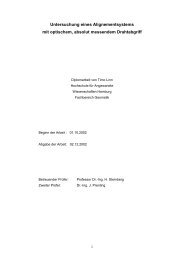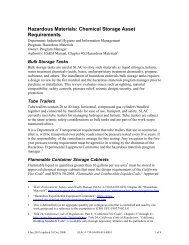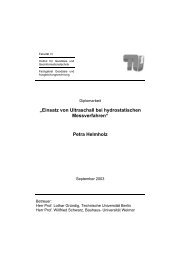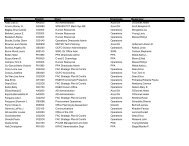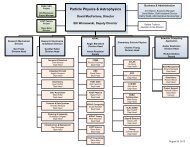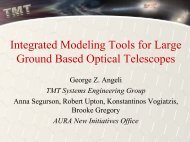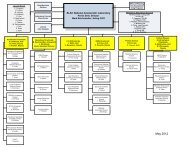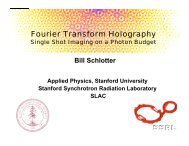BES - SLAC Group/Department Public Websites - Stanford University
BES - SLAC Group/Department Public Websites - Stanford University
BES - SLAC Group/Department Public Websites - Stanford University
Create successful ePaper yourself
Turn your PDF publications into a flip-book with our unique Google optimized e-Paper software.
FYO7 <strong>SLAC</strong> S CIENCE AND T ECHNOLOGY S ELF E VALUATION<br />
A more precise measurements of CP violation in B decays to double-charm final states<br />
BDD(bar),<br />
The time-dependent CP violation in the decay Bρ 0 ρ 0 ,<br />
The semileptonic branching fractions in B decays.<br />
The CP violation measurements in the decays BDD are consistent with the Standard Model and<br />
rule out large direct CP violation in this mode. The time-dependent CP asymmetry measurement in<br />
Bρ 0 ρ 0 represents a major step in removing the ambiguities in the determination of the angle α. The<br />
measurements continue to hold to the CKM picture, which imposes significant constraints on models<br />
of physics beyond the Standard Model, including the supersymmetric extensions of the Standard<br />
Model.<br />
Search for the Effects of Physics Beyond the Standard Model: A key element of the BABAR<br />
physics program is seeking the effects of New Physics through loop-dominated rare decays of B<br />
mesons. A clean set of observables sensitive to the effects of New Physics are time-dependent CP<br />
violating parameters in the so-called b → sss penguin diagrams containing virtual quarks and vector<br />
0 0<br />
bosons. While such modes, including B → ϕK<br />
, 0 0<br />
B → η′ K and a number of related channels, should<br />
show the same CP asymmetry as the benchmark charmonium result for sin2β, they are also sensitive<br />
to New Physics at high mass scales BABAR has performed a comprehensive set of measurements of<br />
CP asymmetries in these channels. BABAR presented new results based on Runs 1-5, including a<br />
complete time-dependent Dalitz analysis of the decay BΚπ + π − . The “naïve” average of the<br />
measurements continues to show a nearly 2.5 standard deviation discrepancy with the predictions of<br />
the Standard Model. Improving precision of these measurements is among the highest priorities of<br />
the experiment.<br />
A set of measurements of the decays ΒD (∗) τν, which complete the semileptonic picture of B meson<br />
decays, provide yet another window on physics beyond the Standard Model, owing to dependence of<br />
the branching fractions on the mass of the charged Higgs. At current uncertainty levels, the data is<br />
consistent with the Standard Model.<br />
Analysis and Simulation Tools: The BABAR collaboration has developed or contributed to many<br />
analysis and simulation software tools now in use in high energy physics and other fields. In FY07,<br />
the Stat Pattern Recognition package for multivariate classification and “data mining,” that is now<br />
maintained as open-source software and used outside HEP, was further developed with additional<br />
capabilities, and was used to provide significant improvements in particle identification performance.<br />
BABAR members contributed to a similar package, TMVA, which is also now in wide use.<br />
The RooFit package for data modeling, developed within BABAR to address complex requirements of<br />
time-dependent CP fits, continues to be developed. It is now distributed as part of the ROOT system,<br />
almost universally used in high energy physics and increasingly adopted in other scientific<br />
communities.<br />
In FY07 BABAR members also contributed to the validation of new releases of the standard particleinteraction<br />
simulation toolkit, GEANT4, widely used in HEP, nuclear physics, medical imaging, and<br />
beyond. A BABAR collaborator is also a member of the core GEANT4 development team.<br />
Objective 1.2 Leadership in Science and Technology<br />
The BABAR experiment at <strong>SLAC</strong> is the leading experimental program in the US and among the<br />
leading programs worldwide, focused on investigating CP symmetry breaking using the decays of B<br />
mesons. The collaboration includes 543 physicists from 77 institutions in 10 countries: the US,<br />
Canada, France, Germany, Italy, Netherlands, Norway, Russia, Spain and UK. There are also 520<br />
associate members. The BABAR collaboration, with a young researcher base of about 150 PhD<br />
graduate students and 90 postdoctoral research associates, is one of the leading institutions<br />
worldwide that trains future high energy physicists.<br />
F I N A L P A G E 3 3



